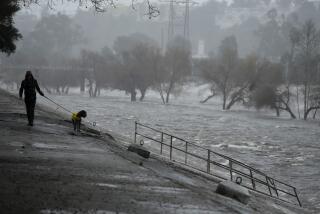William Mulholland’s gift: Modern L.A.
The Times’ editorial board meets around a long table in a room hung with images of the interlocking histories of this newspaper and its city — of Otis Chandler and the election of Ronald Reagan, our endorsement of Barack Obama and the burial of President Nixon.
At the head of that table is a reprint of the front page from Nov. 6, 1913. It memorializes the opening of the Los Angeles Aqueduct, the defining event of this city’s early existence, a fact recognized by the day’s headline: “Silver Torrent Crowns the City’s Mighty Achievement.” Ever since, historians have wrestled over the dealings and subterfuge that brought water to Los Angeles — a debate revived this week with the passing of Catherine Mulholland, whose grandfather and biographical subject, William Mulholland, was either pioneer or pirate, or perhaps both.
Some of the facts are uncontested. Representatives of Los Angeles in the early 20th century recognized that the city’s growth would be stymied without a reliable source of water. They found one in the eastern Sierra Nevada, where the Owens River gathered runoff and carried it to Owens Lake. They quietly began to buy up parcels in the Owens Valley, hiding their true intentions for fear of driving up the cost of land. Then, as word began to leak out, they disclosed that they were bent on diverting that water to Los Angeles. As Catherine Mulholland herself wrote: “Few seemed to care about the action’s moral niceties.”
Among those who most prospered from that achievement were the owners of the Los Angeles Times, and the suspicion has long endured that Mulholland and the city’s power brokers conspired to snatch water for their own enrichment. Catherine Mulholland portrayed her grandfather less venally, as a devoted public servant looking out for the future of his city. She made a good case, though it did not convince everyone.
We will not resolve that matter here, and we’re probably not the ones to do it. But this much can be said: Without William Mulholland, there would be no modern Los Angeles. His engineer’s eye plotted the Los Angeles Aqueduct and brought the water over 230 miles to these dry valleys by gravity alone, an engineering marvel and a civic triumph, albeit at the expense of the Owens Valley, which quickly turned to dust. On the day the water first cascaded down that aqueduct, Mulholland delivered what the Los Angeles Times, admittedly not without bias, described as “the most eloquent and effective address of the day.” As every student of California history knows, it consisted, in its entirety, of this: “There it is. Take it!”
Not until Richard Riordan visited the Owens Valley in 1997 did a Los Angeles mayor dare set foot again in the land whose water made this city possible. Long-memoried residents carried signs deriding him as “King Riordan,” and one suggested a little arsenic would spice up his sauce at the barbecue held in his honor. He handled it in good cheer. Without the aqueduct, there wouldn’t have been much of a city for him to run.
More to Read
A cure for the common opinion
Get thought-provoking perspectives with our weekly newsletter.
You may occasionally receive promotional content from the Los Angeles Times.






